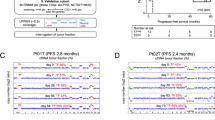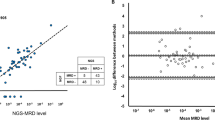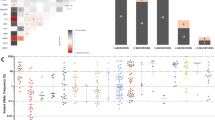Abstract
We have analyzed the applicability, sensitivity and prognostic value of allele-specific oligonucleotide real-time quantitative PCR (ASO RQ-PCR) as a method for minimal residual disease (MRD) assessment in patients with multiple myeloma (MM), comparing the results with those of multiparameter flow cytometry (MFC). A total of 170 patients enrolled in three consecutive Spanish trials achieving at least partial response after treatment were included. Lack of clonality detection (n=31), unsuccessful sequencing (n=17) and suboptimal ASO performance (n=51) limited the applicability of PCR to 42% of cases. MRD was finally investigated in 103 patients (including 32 previously studied) with persistent disease identified by PCR and MFC in 54% and 46% of cases, respectively. A significant correlation in MRD quantitation by both the techniques was noted (r=0.881, P<0.001), being reflective of treatment intensity. Patients with <10−4 residual tumor cells showed longer progression-free survival (PFS) compared with the rest (not reached (NR) vs 31 months, P=0.002), with similar results observed with MFC. Among complete responders (n=62), PCR discriminated two risk groups with different PFS (49 vs 26 months, P=0.001) and overall survival (NR vs 60 months, P=0.008). Thus, although less applicable than MFC, ASO RQ-PCR is a powerful technique to assess treatment efficacy and risk stratification in MM.
This is a preview of subscription content, access via your institution
Access options
Subscribe to this journal
Receive 12 print issues and online access
$259.00 per year
only $21.58 per issue
Buy this article
- Purchase on Springer Link
- Instant access to full article PDF
Prices may be subject to local taxes which are calculated during checkout



Similar content being viewed by others
Accession codes
References
Lahuerta JJ, Mateos MV, Martinez-Lopez J, Rosiñol L, Sureda A, de la Rubia J et al. Influence of pre- and post-transplantation responses on outcome of patients with multiple myeloma: sequential improvement of response and achievement of complete response are associated with longer survival. J Clin Oncol 2008; 26: 5775–5782.
Harousseau JL, Attal M, Avet-Loiseau H . The role of complete response in multiple myeloma. Blood 2009; 114: 3139–3146.
Barlogie B, Tricot G, Anaissie E, Shaughnessy J, Rasmussen E, van Rhee F et al. Thalidomide and hematopoietic-cell transplantation for multiple myeloma. N Engl J Med 2006; 354: 1021–1030.
Palumbo A, Gay F, Falco P, Crippa C, Montefusco V, Patriarca F et al. Bortezomib as induction before autologous transplantation, followed by lenalidomide as consolidation-maintenance in untreated multiple myeloma patients. J Clin Oncol 2010; 28: 800–807.
Mateos MV, Oriol A, Martínez-López J, Gutiérrez N, Teruel AI, de la Paz R et al. Bortezomib, melphalan, and prednisone versus bortezomib, thalidomide, and prednisone as induction therapy followed by maintenance treatment with bortezomib and thalidomide versus bortezomib and prednisone in elderly patients with untreated multiple myeloma: a randomised trial. Lancet Oncol 2010; 11: 934–941.
San Miguel JF, Schlag R, Khuageva NK, Dimopoulos MA, Shpilberg O, Kropff M et al. Bortezomib plus melphalan and prednisone for initial treatment of multiple myeloma. N Engl J Med 2008; 359: 906–917.
Kyle RA, Leong T, Li S, Oken MM, Kay NE, Van Ness B et al. Complete response in multiple myeloma: clinical trial E9486, an Eastern Cooperative Oncology Group study not involving stem cell transplantation. Cancer 2006; 106: 1958–1966.
Palumbo A, Bringhen S, Liberati AM, Caravita T, Falcone A, Callea V et al. Oral melphalan, prednisone, and thalidomide in elderly patients with multiple myeloma: updated results of a randomized, controlled trial. Blood 2008; 112 (8): 3107–3114.
Facon T, Mary JY, Hulin C, Benboubker L, Attal M, Pegourie B et al. Melphalan and prednisone plus thalidomide versus melphalan and prednisone alone or reduced-intensity autologous stem cell transplantation in elderly patients with multiple myeloma (IFM 99-06): a randomised trial. Lancet 2007; 370: 1209–1218.
Chanan-Khan AA, Giralt S . Importance of achieving a complete response in multiple myeloma, and the impact of novel agents. J Clin Oncol 2010; 28: 2612–2624.
Rajkumar SV, Harousseau JL, Durie B, Anderson KC, Dimopoulos M, Kyle R et al. Consensus recommendations for the uniform reporting of clinical trials: report of the International Myeloma Workshop Consensus Panel 1. Blood 2011; 117: 4691–4695.
Brüggemann M, Schrauder A, Raff T, Pfeifer H, Dworzak M, Ottmann OG et al. Standardized MRD quantification in European ALL trials: proceedings of the Second International Symposium on MRD assessment in Kiel, Germany, 18–20 September 2008. Leukemia 2010; 24: 521–535.
Santamaría C, Chillón MC, Fernández C, Martín-Jiménez P, Balanzategui A, García-Sanz R et al. Using quantification of the PML-RARalpha transcript to stratify the risk of relapse in patients with acute promyelocytic leukemia. Haematologica 2007; 92: 315–322.
Baccarani M, Cortes J, Pane F, Niederwieser D, Saglio G, Apperley J et al. Chronic myeloid leukemia: an update of concepts and management recommendations of European LeukemiaNet. J Clin Oncol 2009; 27: 6041–6051.
van der Velden VH, Cazzaniga G, Schrauder A, Hancock J, Bader P, Panzer-Grumayer ER et al. Analysis of minimal residual disease by Ig/TCR gene rearrangements: guidelines for interpretation of real-time quantitative PCR data. Leukemia 2007; 21: 604–611.
Corradini P, Cavo M, Lokhorst H, Martinelli G, Terragna C, Majolino I et al. Molecular remission after myeloablative allogeneic stem cell transplantation predicts a better relapse-free survival in patients with multiple myeloma. Blood 2003; 102: 1927–1929.
Corradini P, Voena C, Tarella C, Astolfi M, Ladetto M, Palumbo A et al. Molecular and clinical remissions in multiple myeloma: role of autologous and allogeneic transplantation of hematopoietic cells. J Clin Oncol 1999; 17: 208–215.
Martinelli G, Terragna C, Zamagni E, Ronconi S, Tosi P, Lemoli RM et al. Molecular remission after allogeneic or autologous transplantation of hematopoietic stem cells for multiple myeloma. J Clin Oncol 2000; 18: 2273–2281.
García-Sanz R, López-Pérez R, Langerak AW, González D, Chillón MC, Balanzategui A et al. Heteroduplex PCR analysis of rearranged immunoglobulin genes for clonality assessment in multiple myeloma. Haematologica 1999; 84: 328–335.
Sarasquete ME, García-Sanz R, González D, Martínez J, Mateo G, Martínez P et al. Minimal residual disease monitoring in multiple myeloma: a comparison between allelic-specific oligonucleotide real-time quantitative polymerase chain reaction and flow cytometry. Haematologica 2005; 90: 1365–1372.
Ladetto M, Pagliano G, Ferrero S, Cavallo F, Drandi D, Santo L et al. Major tumor shrinking and persistent molecular remissions after consolidation with bortezomib, thalidomide, and dexamethasone in patients with autografted myeloma. J Clin Oncol 2010; 28: 2077–2084.
Bakkus MH, Bouko Y, Samson D, Apperley JF, Thielemans K, Van Camp B et al. Post-transplantation tumour load in bone marrow, as assessed by quantitative ASO-PCR, is a prognostic parameter in multiple myeloma. Br J Haematol 2004; 126: 665–674.
Putkonen M, Kairisto V, Juvonen V, Pelliniemi TT, Rauhala A, Itälä-Remes M et al. Depth of response assessed by quantitative ASO-PCR predicts the outcome after stem cell transplantation in multiple myeloma. Eur J Haematol 2010; 85: 416–423.
Korthals M, Sehnke N, Kronenwett R, Bruns I, Mau J, Zohren F et al. The level of minimal residual disease in the bone marrow of patients with multiple myeloma before high-dose therapy and autologous blood stem cell transplantation is an independent predictive parameter. Biol Blood Marrow Transplant 2012; 18: 423–431.
Paiva B, Vidriales MB, Pérez JJ, Mateo G, Montalbán MA, Mateos MV et al. Multiparameter flow cytometry quantification of bone marrow plasma cells at diagnosis provides more prognostic information than morphological assessment in myeloma patients. Haematologica 2009; 94: 1599–1602.
Rawstron AC, Davies FE, DasGupta R, Ashcroft AJ, Patmore R, Drayson MT et al. Flow cytometric disease monitoring in multiple myeloma: the relationship between normal and neoplastic plasma cells predicts outcome after transplantation. Blood 2002; 100: 3095–3100.
Paiva B, Martínez-López J, Vidriales MB, Mateos MV, Montalbán MA, Férnandez-Redondo E et al. Comparison of immunofixation, serum free light chain, and immunophenotyping for response evaluation and prognostication in multiple myeloma. J Clin Oncol 2011; 29: 1627–1633.
Lioznov M, Badbaran A, Fehse B, Bacher U, Zander AR, Kröger NM . Monitoring of minimal residual disease in multiple myeloma after allo-SCT: flow cytometry vs PCR-based techniques. Bone Marrow Transplant 2008; 41: 913–916.
Martínez-Sánchez P, Montejano L, Sarasquete ME, García-Sanz R, Fernández-Redondo E, Ayala R et al. Evaluation of minimal residual disease in multiple myeloma patients by fluorescent-polymerase chain reaction: the prognostic impact of achieving molecular response. Br J Haematol 2008; 142: 766–774.
Rosiñol L, Oriol A, Teruel AI, Hernández D, López-Jiménez J, de la Rubia J et al. Superiority of bortezomib, thalidomide, and dexamethasone (VTD) as induction pretransplantation therapy in multiple myeloma: a randomized phase 3 PETHEMA/GEM study. Blood 2012; 120: 1589–1596.
Martínez-López J, Bladé J, Mateos MV, Grande C, Alegre A, García-Laraña J et al. Long-term prognostic significance of response in multiple myeloma after stem cell transplantation. Blood 2011; 118: 529–534.
Bladé J, Samson D, Reece D, Apperley J, Björkstrand B, Gahrton G et al. Criteria for evaluating disease response and progression in patients with multiple myeloma treated by high-dose therapy and haemopoietic stem cell transplantation. Myeloma Subcommittee of the EBMT. European Group for Blood and Marrow Transplant. Br J Haematol 1998; 102: 1115–1123.
van Dongen JJ, Langerak AW, Brüggemann M, Evans PA, Hummel M, Lavender FL et al. Design and standardization of PCR primers and protocols for detection of clonal immunoglobulin and T-cell receptor gene recombinations in suspect lymphoproliferations: report of the BIOMED-2 Concerted Action BMH4-CT98-3936. Leukemia 2003; 17: 2257–2317.
López-Pérez R, García-Sanz R, González D, Balanzategui A, Chillón MC, Alaejos I et al. Gene scanning of VDJH-amplified segments is a clinically relevant technique to detect contaminating tumor cells in the apheresis products of multiple myeloma patients undergoing autologous peripheral blood stem cell transplantation. Bone Marrow Transplant 2001; 28: 665–672.
Brochet X, Lefranc MP, Giudicelli V . IMGT/V-QUEST: the highly customized and integrated system for IG and TR standardized V-J and V-D-J sequence analysis. Nucleic Acids Res 2008; 36: W503–W508.
González D, Balanzategui A, García-Sanz R, Gutiérrez N, Seabra C, van Dongen JJ et al. Incomplete DJH rearrangements of the IgH gene are frequent in multiple myeloma patients: immunobiological characteristics and clinical implications. Leukemia 2003; 17: 1398–1403.
van der Velden VH, Hochhaus A, Cazzaniga G, Szczepanski T, Gabert J, van Dongen JJ . Detection of minimal residual disease in hematologic malignancies by real-time quantitative PCR: principles, approaches, and laboratory aspects. Leukemia 2003; 17: 1013–1034.
González D, González M, Alonso ME, López-Pérez R, Balanzategui A, Chillón MC et al. Incomplete DJH rearrangements as a novel tumor target for minimal residual disease quantitation in multiple myeloma using real-time PCR. Leukemia 2003; 17: 1051–1057.
Verhagen OJ, Willemse MJ, Breunis WB, Wijkhuijs AJ, Jacobs DC, Joosten SA et al. Application of germline IGH probes in real-time quantitative PCR for the detection of minimal residual disease in acute lymphoblastic leukemia. Leukemia 2000; 14: 1426–1435.
van der Velden VH, Willemse MJ, van der Schoot CE, Hählen K, van Wering ER, van Dongen JJ . Immunoglobulin kappa deleting element rearrangements in precursor-B acute lymphoblastic leukemia are stable targets for detection of minimal residual disease by real-time quantitative PCR. Leukemia 2002; 16: 928–936.
San Miguel JF, Almeida J, Mateo G, Bladé J, López-Berges C, Caballero D et al. Immunophenotypic evaluation of the plasma cell compartment in multiple myeloma: a tool for comparing the efficacy of different treatment strategies and predicting outcome. Blood 2002; 99: 1853–1856.
Puig N, Sarasquete ME, Alcoceba M, Balanzategui A, Chillón MC, Sebastián E et al. The use of CD138 positively selected marrow samples increases the applicability of minimal residual disease assessment by PCR in patients with multiple myeloma. Ann Hematol 2013; 92: 97–100.
Puig N, Sarasquete ME, Alcoceba M, Balanzategui A, Chillón MC, Sebastián E et al. Kappa deleting element as an alternative molecular target for minimal residual disease assessment by real-time quantitative PCR in patients with multiple myeloma. Eur J Haematol 2012; 89: 328–335.
Fenk R, Ak M, Kobbe G, Steidl U, Arnold C, Korthals M et al. Levels of minimal residual disease detected by quantitative molecular monitoring herald relapse in patients with multiple myeloma. Haematologica 2004; 89: 557–566.
Davies F, Forsyth PD, Rawstron AC, Owen RG, Pratt G, Evans PAS et al. The impact of attaining a minimal residual disease state after high-dose melphalan and autologous transplantataion for multiple myeloma. Br J Haematol 2001; 112: 814–819.
Ladetto M, Bruggemann M, Ferrero S, Pepin F, Drandi D, Monitilo L et alNext-generation sequencing and real-time quantitative PCR for minimal residual disease (MRD) detection using the immunoglobulin heavy chain variable region: a methodical comparison in acute lymphoblastic leukemia (ALL), mantle cell lymphoma (MCL) and multiple myeloma (MM). ASH Annual Meeting Abstracts 2012; #788.
Walker BA, Wardell CP, Johnson DC, Kaiser MF, Begum DB, Dahir NB et al. Characterization Of IgH breakpoints in multiple myeloma indicates a subset of translocations appear to occur In pre-germinal center B cells. Blood 2013; 121: 3413–3419.
van Dongen JJ, Lhermitte L, Böttcher S, Almeida J, van der Velden VH, Flores-Montero J et al. EuroFlow antibody panels for standardized n-dimensional flow cytometric immunophenotyping of normal, reactive and malignant leukocytes. Leukemia 2012; 26: 1908–1975.
San Miguel J, Harousseau JL, Joshua D, Anderson KC . Individualizing treatment of patients with myeloma in the era of novel agents. J Clin Oncol 2008; 26: 2761–2766.
Wirk B, Wingard JR, Moreb JS . Extramedullary disease in plasma cell myeloma: the iceberg phenomenon. Bone Marrow Transplant 2013; 48: 10–18.
Acknowledgements
We thank Alicia Antón and Rebeca Maldonado for their technical assistance. This work has been partially supported by the Grants PS09/01450 and PI12/02311 from the Spanish ‘Instituto de Salud Carlos III (ISCIII)’, the Grants RD12/0036/0069 and 0058 from ‘Red Temática de Investigación Cooperativa en Cáncer (RTICC), Spanish Ministry of Economy and Competitiveness’ and European Regional Development Fund (ERDF) ‘Una manera de hacer Europa’, Grant number HUS412A12-1 from the ‘Consejería de Educación de la Junta de Castilla y León’ and Grant GCB-120981SAN from the ‘Asociación Española Contra el Cáncer (AECC)’. NP was partially supported by a grant from the SEHH (Sociedad Española de Hematología y Hemoterapia).
Author information
Authors and Affiliations
Corresponding author
Ethics declarations
Competing interests
The authors declare no conflict of interest.
Additional information
Supplementary Information accompanies this paper on the Leukemia website
Rights and permissions
About this article
Cite this article
Puig, N., Sarasquete, M., Balanzategui, A. et al. Critical evaluation of ASO RQ-PCR for minimal residual disease evaluation in multiple myeloma. A comparative analysis with flow cytometry. Leukemia 28, 391–397 (2014). https://doi.org/10.1038/leu.2013.217
Received:
Revised:
Accepted:
Published:
Issue Date:
DOI: https://doi.org/10.1038/leu.2013.217
Keywords
This article is cited by
-
Clinical Outcomes and Serum B-Cell Maturation Antigen Levels in a Real-World Unselected Population of Newly Diagnosed Multiple Myeloma Patients
Targeted Oncology (2023)
-
Plasma cell myeloma: role of histopathology, immunophenotyping, and genetic testing
Skeletal Radiology (2022)
-
Minimal residual disease in multiple myeloma: current status
Biomarker Research (2021)
-
Minimal residual disease detection in multiple myeloma: comparison between BML single-tube 10-color multiparameter flow cytometry and EuroFlow multiparameter flow cytometry
Annals of Hematology (2021)
-
International harmonization in performing and reporting minimal residual disease assessment in multiple myeloma trials
Leukemia (2021)



